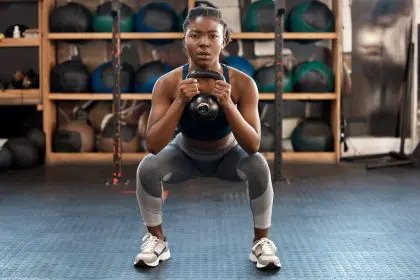Remember when getting a personalized workout plan meant paying a personal trainer $100 an hour or following cookie-cutter routines from fitness magazines that assumed everyone had the same body, goals, and limitations? Now artificial intelligence is promising to create customized fitness programs tailored specifically to your needs, schedule, and preferences for the price of a monthly app subscription.
The AI fitness revolution sounds incredible on paper – algorithms that can analyze your fitness level, track your progress, adjust your workouts based on performance data, and provide the kind of personalized coaching that was previously only available to elite athletes or wealthy gym members. But there’s something unsettling about trusting a machine to design exercise routines that could potentially injure you if they get the programming wrong.
The question isn’t whether AI can create workout plans – it’s whether those plans are actually safe, effective, and superior to human-designed alternatives, or whether we’re essentially beta-testing fitness algorithms with our own bodies while tech companies figure out how to avoid liability for exercise-related injuries.
The data analysis that’s actually impressive
AI workout platforms can process and analyze fitness data in ways that would be impossible for human trainers to match. They can track your heart rate patterns, recovery metrics, strength progression, sleep quality, and dozens of other variables to create workout recommendations that adapt in real-time based on how your body is responding to training.
This level of data integration means that AI can potentially catch overtraining patterns, identify when you need more recovery time, or recognize when you’re ready to increase intensity in ways that even experienced trainers might miss. The algorithms can also adjust workouts based on factors like stress levels, sleep quality, or changes in your schedule that affect your training capacity.
The personalization potential is genuinely impressive when it works correctly. AI can create workout variations that account for equipment limitations, time constraints, injury history, and specific goals while continuously refining the program based on your actual performance rather than generic assumptions about what should work.
The human expertise that’s getting lost
Personal trainers don’t just create workout plans – they provide motivation, form corrections, safety oversight, and the kind of intuitive adjustments that come from years of experience working with real bodies in real gym environments. AI can analyze data, but it can’t spot when your form is breaking down or recognize the subtle signs that you’re about to injure yourself.
The complexity of human movement and exercise physiology involves countless variables that may not show up in the data that AI systems can measure. A good trainer can observe compensatory movement patterns, emotional states, or environmental factors that affect exercise safety and effectiveness but don’t translate into measurable metrics.
There’s also the motivational and accountability aspect that AI struggles to replicate authentically. While apps can send notifications and provide encouragement through text or voice prompts, they can’t provide the human connection and genuine support that often makes the difference between consistent training and giving up when things get difficult.
The injury risk that nobody wants to discuss
The most concerning aspect of AI-generated workout plans is the potential for exercise prescriptions that look good on paper but create injury risk in real-world application. AI systems are only as good as their training data, and if that data doesn’t adequately represent your specific body type, movement patterns, or injury history, the recommendations could be dangerously inappropriate.
Many AI fitness platforms rely on user self-reporting for injury history, pain levels, and exercise experience, but people often underestimate their limitations or overestimate their capabilities. When AI creates workout plans based on inaccurate self-assessments, the result can be exercise prescriptions that exceed safe training parameters.
The liability questions surrounding AI-generated fitness advice remain largely unresolved. When someone gets injured following an AI workout plan, determining responsibility becomes complicated in ways that don’t exist with human trainers who carry professional liability insurance and are bound by certification standards.
The cookie-cutter algorithms disguised as personalization
Despite claims of personalization, many AI workout platforms are essentially sophisticated sorting systems that categorize users into predetermined groups and assign corresponding workout templates. True personalization would require AI systems to understand individual biomechanics, movement quality, and response patterns in ways that current technology can’t achieve.
The personalization often focuses on easily measurable variables like age, weight, and stated goals while ignoring complex factors like movement quality, injury history, or individual response to different training stimuli. This can create an illusion of customization while actually providing relatively generic programming dressed up with personalized data points.
Many users report that AI workout plans feel repetitive or fail to account for important individual factors that would be obvious to human trainers. The algorithms may excel at adjusting weights and reps based on performance data but struggle with the nuanced programming decisions that require understanding of exercise physiology and individual variation.
The progression logic that might be flawed
AI workout systems typically use linear progression models that assume consistent improvement over time, but human fitness development is rarely linear and involves plateaus, setbacks, and periods of rapid advancement that don’t follow predictable patterns. When AI fails to account for these natural variations, it can create frustration or inappropriate training loads.
The algorithms may also prioritize metrics that are easy to measure, like weight lifted or distance covered, while undervaluing factors like movement quality, recovery, or long-term joint health that are crucial for sustainable fitness development. This can lead to programming that optimizes for short-term measurable improvements at the expense of long-term health and performance.
Progressive overload principles that work well for some individuals may be inappropriate for others based on factors like age, training history, or genetic predisposition to injury. AI systems may not adequately account for these individual differences when designing progression schemes.
The motivation problem that algorithms can’t solve
Exercise adherence and long-term fitness success depend heavily on motivation, enjoyment, and psychological factors that AI systems struggle to address effectively. While apps can gamify workouts and provide virtual rewards, they can’t replicate the human connection and genuine encouragement that often determine whether people stick with fitness routines.
AI motivation strategies tend to rely on generic psychological techniques that may not resonate with individual personality types or motivational styles. What motivates one person might actually demotivate another, but AI systems often lack the sophistication to recognize and adapt to these individual differences.
The social aspects of fitness that many people find motivating – working out with others, having a training partner, or being part of a fitness community – are difficult for AI systems to facilitate in meaningful ways that create genuine connection and accountability.
The cost-benefit analysis that’s surprisingly complex
AI workout plans are typically much cheaper than personal training, making personalized fitness guidance accessible to people who couldn’t otherwise afford it. This democratization of fitness coaching could have significant public health benefits if the AI recommendations are safe and effective for the majority of users.
However, the hidden costs of AI fitness coaching might include increased injury risk, less effective programming, or the need to eventually hire human trainers to correct problems created by AI recommendations. The apparent cost savings could be offset by these downstream expenses.
The value proposition depends heavily on your individual needs and experience level. AI workout plans might be perfectly adequate for experienced exercisers who understand proper form and can recognize when something doesn’t feel right, but potentially problematic for beginners who lack the knowledge to identify inappropriate exercise prescriptions.
The future that’s probably inevitable
The integration of AI into fitness coaching is likely to continue expanding regardless of current limitations, as the technology improves and more people become comfortable with algorithm-based health recommendations. The key will be finding the right balance between AI efficiency and human expertise.
The most promising approaches may be hybrid models that combine AI data analysis with human oversight, using technology to handle routine programming and progression while relying on human trainers for form instruction, motivation, and safety oversight. This could provide the best of both worlds while minimizing the risks of fully automated fitness coaching.
As AI fitness technology evolves, the platforms that prioritize safety, acknowledge their limitations, and integrate human expertise appropriately will likely succeed, while those that oversell AI capabilities or ignore safety considerations may face liability issues that force industry-wide improvements in standards and practices.















